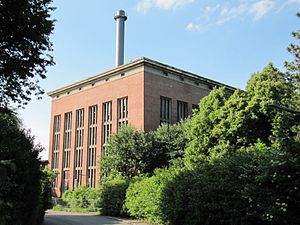Aubingen thermal power station
| Aubingen thermal power station | |||
|---|---|---|---|
| View from the southeast. | |||
| location | |||
|
|
|||
| Coordinates | 48 ° 9 ′ 45 " N , 11 ° 25 ′ 30" E | ||
| country | Germany | ||
| Data | |||
| Type | Thermal power station | ||
| Project start | 1937 | ||
| Shutdown | 1964 | ||
The former Aubingen thermal power station is an industrial building in the Munich district of Aubing , on Rupert-Bodner-Straße, which has been a listed building since 2007 .
history
The power plant was planned in 1937 as part of an unfinished industrial plant of the Reichsbahn and built from 1940. Previously, archaeological excavations were carried out in order to open up parts of a Bavarian burial ground (see the section Archaeological Finds in History of Aubing ). During the Second World War, the Reichsbahn facilities in Aubing were bombed, and after the end of the war the facility was initially unused. In 1952, the Deutsche Bundesbahn converted the hall into a thermal power station . Since its shutdown, probably twelve years later, the hall has been empty.
In the 1990s, techno parties took place in the building, with Monika Kruse as a DJ , among others .
In 2005 the former railway company Vivico sold the hall with the 20,000 square meter site with protected trees to the oil company and petrol station operator Allguth , who wanted to set up a company headquarters here. The planning was carried out by the Munich architects Haack und Höpfner, and a building application was submitted in 2006. However, despite the approval, construction did not begin, instead Allguth sold again in late 2010 / early 2011. In March 2011, the new owner was unknown. In the meantime, Allguth GmbH is the owner again.
architecture
The hall is 45 meters wide and 25 meters high. The facade of the three sides of the building, preserved in their original state, consists of brickwork, which is dominated by 20 meter high ribbon windows. The window frames and the neoclassical cornice on the roof are made of Nagelfluh . The west facade, on the other hand, is a makeshift construction from the 1950s. The poor state of preservation of the hall, especially the roof, was an issue in November 2010 in the responsible district committee of Aubing-Lochhausen-Langwied .
Web links
Individual evidence
- ↑ a b c d Martin Bernstein: Industrial cathedral is in ruins . In: Süddeutsche Zeitung . March 29, 2011, p. R7 .
- ^ Website ( memento of December 17, 2014 in the Internet Archive ) by the architects Haack and Höpfner, accessed on December 19, 2012.
- ↑ HKW Aubing - allguth.de. Retrieved on August 7, 2018 (See section AUBINGER ZEITZEUGEN WANTED: "We as owners of the former power station [...]").
- ^ Website of the Wochenanzeiger München, accessed on April 1, 2011





